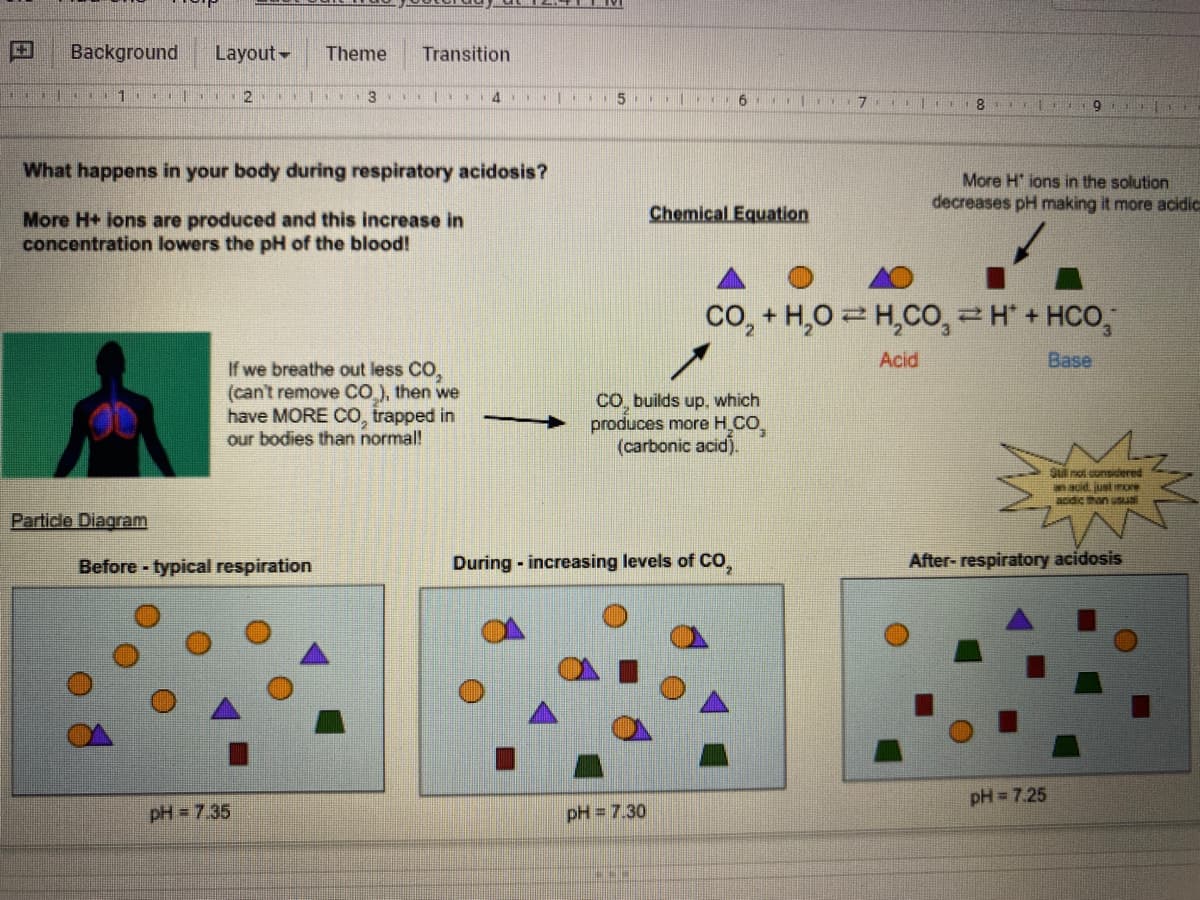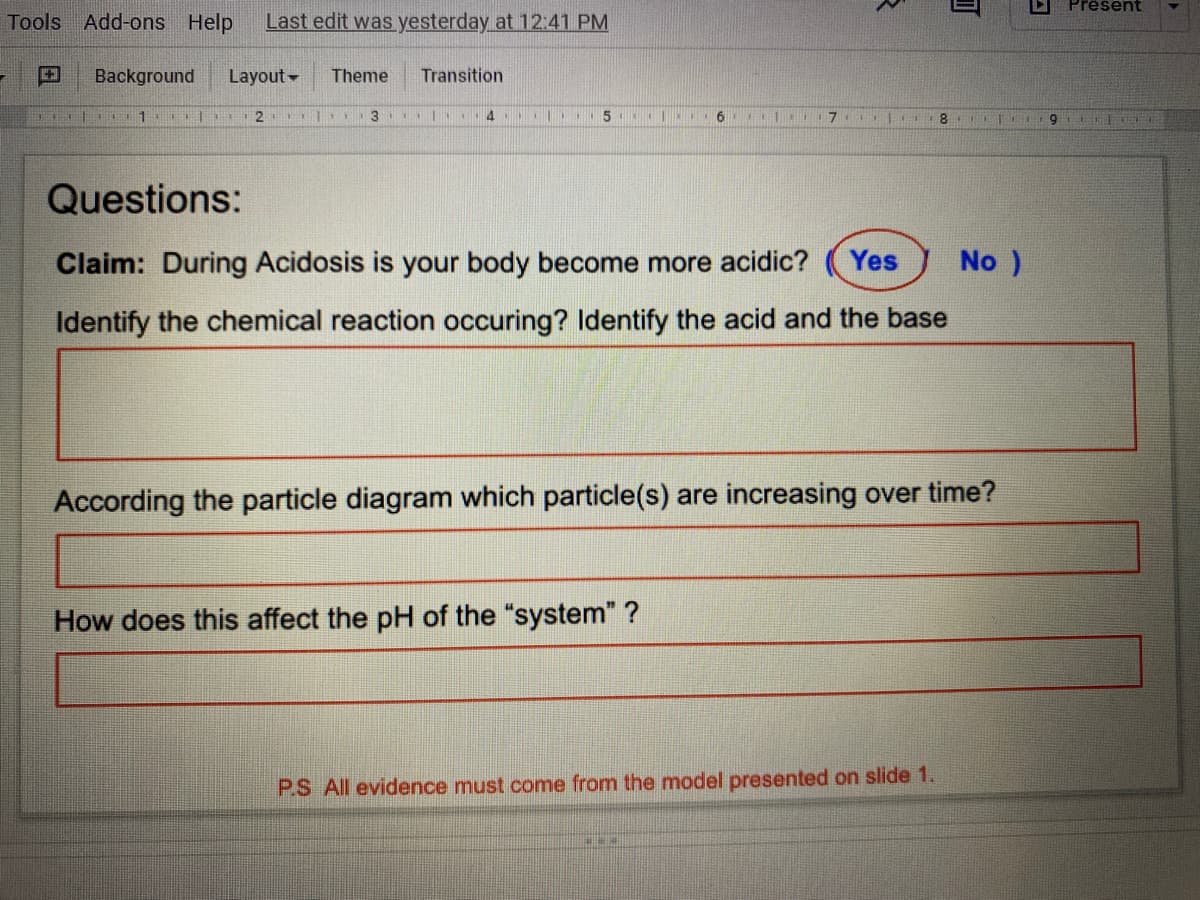Identify the chemical reaction occuring? Identify the acid and the base According the particle diagram which particle(s) are increasing over time? How does this affect the pH of the "system" ?
Identify the chemical reaction occuring? Identify the acid and the base According the particle diagram which particle(s) are increasing over time? How does this affect the pH of the "system" ?
Principles of Modern Chemistry
8th Edition
ISBN:9781305079113
Author:David W. Oxtoby, H. Pat Gillis, Laurie J. Butler
Publisher:David W. Oxtoby, H. Pat Gillis, Laurie J. Butler
Chapter15: Acid–base Equilibria
Section: Chapter Questions
Problem 103AP
Related questions
Question
someone help with all three questions, as the first picture was to use as evidence

Transcribed Image Text:Background
Layout-
Theme
Transition
12
1..3 Ll. 4 .
5 111 6
What happens in your body during respiratory acidosis?
More H ions in the solution
decreases pH making it more acidic
Chemical Equation
More H+ ions are produced and this increase in
concentration lowers the pH of the blood!
co, + H,0 H,Co, H + HCO,
Acid
Base
If we breathe out less CO,
(can't remove CO), then we
have MORE CO, trapped in
our bodies than normal!
CO, builds up, which
produces more H,CO,
(carbonic acid).
Sul not considered
maud. just more
Particle Diagram
Before -typical respiration
During - increasing levels of CO,
After- respiratory acidosis
pH 7.25
pH 7.35
pH = 7.30

Transcribed Image Text:Présent
Tools Add-ons Help
Last edit was yesterday at 12:41 PM
Background
Layout-
Theme
Transition
3 | 4
6.
Questions:
Claim: During Acidosis is your body become more acidic?
Yes
No )
Identify the chemical reaction occuring? Identify the acid and the base
According the particle diagram which particle(s) are increasing over time?
How does this affect the pH of the "system"?
P.S All evidence must come from the model presented on slide 1.
Expert Solution
This question has been solved!
Explore an expertly crafted, step-by-step solution for a thorough understanding of key concepts.
Step by step
Solved in 2 steps with 1 images

Knowledge Booster
Learn more about
Need a deep-dive on the concept behind this application? Look no further. Learn more about this topic, chemistry and related others by exploring similar questions and additional content below.Recommended textbooks for you

Principles of Modern Chemistry
Chemistry
ISBN:
9781305079113
Author:
David W. Oxtoby, H. Pat Gillis, Laurie J. Butler
Publisher:
Cengage Learning

Chemistry & Chemical Reactivity
Chemistry
ISBN:
9781337399074
Author:
John C. Kotz, Paul M. Treichel, John Townsend, David Treichel
Publisher:
Cengage Learning

Chemistry & Chemical Reactivity
Chemistry
ISBN:
9781133949640
Author:
John C. Kotz, Paul M. Treichel, John Townsend, David Treichel
Publisher:
Cengage Learning

Principles of Modern Chemistry
Chemistry
ISBN:
9781305079113
Author:
David W. Oxtoby, H. Pat Gillis, Laurie J. Butler
Publisher:
Cengage Learning

Chemistry & Chemical Reactivity
Chemistry
ISBN:
9781337399074
Author:
John C. Kotz, Paul M. Treichel, John Townsend, David Treichel
Publisher:
Cengage Learning

Chemistry & Chemical Reactivity
Chemistry
ISBN:
9781133949640
Author:
John C. Kotz, Paul M. Treichel, John Townsend, David Treichel
Publisher:
Cengage Learning


Chemistry
Chemistry
ISBN:
9781305957404
Author:
Steven S. Zumdahl, Susan A. Zumdahl, Donald J. DeCoste
Publisher:
Cengage Learning

Chemistry: An Atoms First Approach
Chemistry
ISBN:
9781305079243
Author:
Steven S. Zumdahl, Susan A. Zumdahl
Publisher:
Cengage Learning